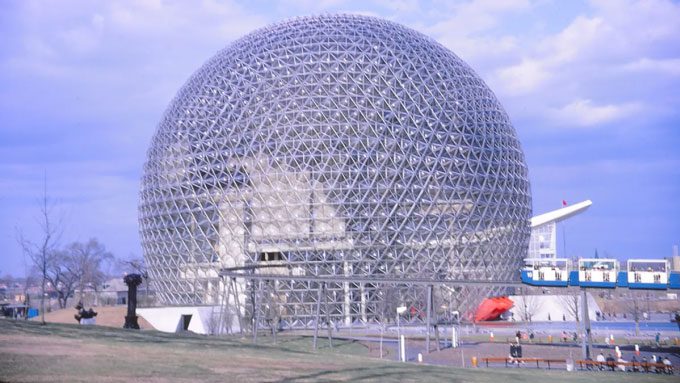The inventor Buckminster Fuller proposed an idea known as “Space City” in the 1960s.
This concept involves constructing cities or living facilities for humans on massive spherical structures, referred to as “Space Structures”, utilizing solar energy to generate heat and lift into the atmosphere.
Buckminster Fuller, an American architect and inventor, introduced the idea of building Cloud Nine in the 1960s. Essentially, Cloud Nine consists of gigantic floating spheres designed for human habitation. Fuller’s vision is based on the geodesic dome, which comprises many triangular panels forming a thin-shelled structure resembling a large sphere. The advantage of this construction method is the distribution of pressure across the entire structure.

A geodesic dome designed by Buckminster Fuller. (Photo: Laurent Bélanger/Wikimedia Commons).
The triangular shape is the only arrangement of structural components that can be stable on its own without additional connections at the joints to prevent geometric distortion, according to Outdoor Igloos, a company that produces geodesic domes. In other words, applying pressure to one side of a triangle distributes that force evenly to the other two sides, which then transmits pressure to adjacent triangles. This distribution of pressure is how geodesic domes effectively diffuse stress throughout the entire structure.
Interestingly, as the spheres and geodesic domes increase in size, they become significantly more robust. Moreover, as the radius of the sphere increases, its volume grows at an even faster rate.
Next, consider buoyancy. Buoyancy is an upward force in a fluid (any substance that flows, including air) acting on all objects within it. This force arises from the pressure within the fluid becoming greater as an object is submerged deeper. The pressure at the bottom of an object in a fluid is higher than at the top of that object, generating an upward force.
If the buoyant force of the fluid exceeds the weight of the object, then that object will float. Helium can rise because it is lighter than other elements in Earth’s atmosphere. The same phenomenon occurs when the air inside a balloon is heated and expands, causing its density to become lower than the surrounding air, allowing it to ascend.
Fuller believed that if the air inside a colossal geodesic dome were heated, even just one degree Celsius above the ambient temperature, the dome could rise. According to him, such a balloon could lift a significant mass, enabling humans to inhabit floating spherical cities in the sky.
However, whether this method is practically feasible remains unverified. Some experts have calculated that creating living areas, assuming in layers, would quickly make the entire system too heavy. This would render the floating sphere city highly impractical, not to mention the risks involved if the sphere were to fall to the ground.
Fuller did not expect Cloud Nine to be realized in the near future. Instead, he proposed this idea as a way to encourage people to think about solutions to the growing population challenge.


















































